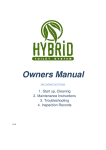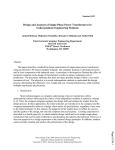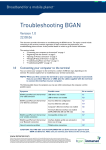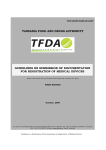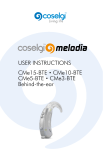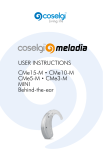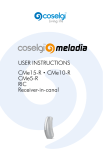Download BAXTER Colleague Infusion Pump Service Manual
Transcript
Colleague Technical formation 1 Welcome to Colleague Technical Training. The following slides are used for technical training purposes and should be used in conjunction with the current service manual. 2 Welcome to Colleague Technical Training. Nigel Atkinson. 3 Colleague 1 & 3 Technical Course At the completion of this Technical Training course, you will be: Able to demonstrate a working knowledge of the Colleague as described in the Service Manual, Familiar with the Mechanical, Electrical and Operational features Able to perform Disassembly, Re-assembly tasks and Repairs to sub assembly level. Able to perform Testing, Preventative Maintenance and Troubleshooting Routines as described in the Service Manual. 4 Training Course Format Logistics – Registration – Breaks – Comfort Stops – Lunch/Dinner – Parking – Introductions Course objectives • At the completion of this Technical Training course, you will be expected to pass with at least 80% in an open book test Learning format • • • • • Show Tell See & Do Q & A - FAQ’s Testing Course evaluation feedback 5 Agenda Day 1 • • • • • • • • • Introductions Infusion Systems Colleague Volumetric Infusion Pump – Video: “A look Inside” Colleague 1 & 3 Overview – Features and Controls Powering Up the pump, Pump Operation. The Menu Tree – Pump Personalities – Pump History The Shuttle Mechanism – Overview – Practical Session – Dismantle and review PHM Troubleshooting a failure Free discussion FAQ’s 6 Agenda Day 2 Day 1 review Personalities Personality data transfer Event History Download Colleague Upgrades Battery harness Keypad Harness Insulator Power Supply PHM Resin Joints Pump strip-down PHM, UIM, PSU Re-build, test & calibration Configuration and Service Screens Preventive Maintenance Repair Test & Inspection Keypad Insulator Installation Calibration Review of Day 2 Course test 7 Welcome to Colleague Technical Training. Introductions. 8 Australian Product Support •Call 1800 063 093 •Spare parts : Marco, Noelene Device Description The Baxter Colleague Volumetric Infusion pump is designed to accurately control and monitor the flow of solutions to the patient. The device is rated for high risk & neonatal use. It is suitable for : General Drug Administration Epidural Procedures Blood Transfusions Chemotherapy TPN (Total Parenteral Nutrition) 10 An Infusion System An infusion system is usually made up of: A solution required to be delivered to a patient: Saline solution to balance patients fluids Saline solution together with added drugs such as antibiotics Nutritional products Solution may be either from a fluid bag, bottle or a syringe or similar container. A line connecting the container to the patient, often described as ‘a giving set’ or ‘administration set’. Sets come in different forms with different elements as part of the set, such as: Special particle filters Injection ports Burette containers A needle or needless system to make the connection to the patients vein or entry site. A pump to control the flow of the solution to the patient over time. 11 The Administration Set The basic administration set used in the Colleague Pump is the standard PVC set incorporating: A spike ( to open the container ) A drip chamber with filter ( to view the drips ) A blue safety slide clamp ( a secondary patient safety device ) A roller clamp ( for controlling the flow when running on gravity ) An injection port (for admin. of drugs ) A Luer lock connection ( for connection to a venflon / needle) The blue safety clamp closes automatically when the set is removed from the pump. This clamp is unique to Baxter devices and must be in place before the device will operate. It is keyed so it will only insert in the correct direction. 12 Infusion Parameters The key parameters for an infusion: The Volume of solution to be delivered to the patient. The Rate of delivery. In the simplest form these are given in Millilitres (ml) and Millilitres per hour (ml/hr), but may be prescribed and programmed differently into the pump. The volume and rate are keyed into the pump and the pump is started. Under normal circumstances the infusion will start and run for the duration of the infusion. For example: Volume = 1000ml, Rate = 125ml/hr The infusion will run for 8 hours. MOVIE 13 Colleague Movie 14 15 Movie Quiz?? 1. 2. 3. 4. 5. 6. 7. 8. 9. 10. What kind of sets are used in the Colleague infusion Pump? What is the core technology in the Colleague? What is the basis of the Shuttle? How many parts are 1ml of fluid resolved into? What is unique about the loading of the administration set? What safety feature exists on all Colleague admin. sets? How many displays are there on Colleague? What are they? What is the purpose of Pump Personalities? How many events are recorded in Event History? 16 1. 7. 8. What kind of sets are used in the Colleague infusion Pump? What is the core technology in the Colleague? What is the basis of the Shuttle? How many parts are 1ml of fluid resolved into? What is unique about the loading of the administration set? What safety feature exists on all Colleague admin. sets? How many displays are there on Colleague? What are they? 9. 10. What is the purpose of Pump Personalities? How many events are recorded in Event History? 2. 3. 4. 5. 6. 1. Standard gravity set 2. 3. 4. The Shuttle Two V blocks 3,414 parts 5. It is automatic 6. 7. 8. The blue ‘ON/OFF’ safety clamp Two Large graphic & Vacuum fluorescent 9. Means of customizing the pump 10. Up to 1000 events 17 PUMP HEAD MECHANISM Why the Shuttle? 18 Rotary & Linear Peristaltic Mechanisms Administration set Fingers move sequentially massaging the tubing Rotor turns allowing each roller to push the fluid along the tubing Fluid flow Rotary Mechanism Linear Mechanism 19 Colleague Shuttle Action 20 The Shuttle Mechanism 21 The Shuttle Mechanism 22 The Shuttle Mechanism 23 The Shuttle Mechanism 24 The Shuttle Mechanism 25 The Shuttle Mechanism 26 The Shuttle Mechanism 27 STOP The Shuttle Mechanism Inlet Valve Outlet Valve Two V Blocks 1 x fixed 1 x moving 28 The Shuttle Mechanism Inlet Valve Outlet Valve Two V Blocks 1 x fixed 1 x moving 29 The Shuttle Mechanism Inlet Valve Outlet Valve Two V Blocks 1 x fixed 1 x moving 30 31 Colleague Technical Information Shuttle Technology Benefits: Maintain accurate delivery over 72 Hrs Micro-Macro Flow Rates (0.1ml/Hr-1200ml/Hr) Uses inexpensive pump compatible gravity giving sets. 32 The Pump Head Module (PHM) 33 34 PUMP HEAD MECHANISM 35 P roxmi a l Tube Load ni gG u di e s lS en F olw t el t r v T ub l e ni g S enso rLev er Tem p Se n Dw n so r s trO Tem cc lS en p S e so r nso r A irS enso rs tel tV a S hu Ou S ol s ni g S o r enso r Le v e trO c c alm p nI el t V a vl e Tub U ps O nO / fC PUMP HEAD MECHANISM Tube Load ni gG u di e s D si at l 36 PUMP HEAD MECHANISM • Occlusion Sensors • Temperature Sensors • Air Sensors. 37 P roxmi a l c lS alm p S ol t Tube Load ni gG u di es F ol w ni g S ens o a vl e rLev er Tube Load ni gG u di es A irS en s o rs pSe ns Dw o r ns tr O Tem cc lS en p S e so r nso r Tem t el tel tV Tub Ou S hu T ub ens ni g S o r ens o rL eve r nI el tV a vl e trO c O/ f C U ps On PUMP HEAD MECHANISM - Occlusion Sensors D si at l 38 Occlusion Detection • • • Cantilever beam strain gauge transducers Upstream and downstream transducers are Zeroed at the beginning of an infusion. Three sensitivity levels for downstream occlusion Flow rate also influences downstream occlusion sensitivity. 39 P roxmi a l Tube Load ni gG u di e s v T ub l e ni g S enso rLev er Tem p Se n Dw n so r s trO Tem cc lS en p S e so r nso r A irS enso rs tel tV a Ou t el S hu nI el t V a vl e s ni g S o r enso r Le v e lS en Tub trO c c U ps O nO / fC alm p S ol t r PUMP HEAD MECHANISM - Temperature Sensors F olw D si at l Tube Load ni gG u di es Shuts Pump down if outside 15o – 38o C Compensates occlusion reaction for changes in tube characteristics 40 P roxmi a l Tube Load ni gG u di es Tub vl e ni g S enso rLev er Tem pSe n Dw n so r s trO Tem cc lS en p S e so r nso r A irS enso rs tel tV a Ou t el S hu nI el t V a vl e s ni g S o r enso rLev e lS en T ub trO c c U ps O nO / fC alm p S ol t r PUMP HEAD MECHANISM - Air Sensor F olw Tube Load ni gG u di es D si at l Transmitter in fixed lower jaw Receiver in retracting upper jaw 4.5 MHz Ultrasonic signal Samples every 10 µl of the infusion. Adds volume of air sensed over volume delivered. . 41 PUMP HEAD MECHANISM - Air Sensor Air in Line PCB (AIL PCB) Small Daughter PCB on PHM PCB Conditions Tx and Rx analogue signals for further processing on PHM PCB 42 PUMP HEAD MECHANISM - Air Sensor 43 Accumulative Air Bubble Size Air setting to 25 microlitres Air bubble in any 830 microlitres Air setting to 50 microlitres Air bubble in any 1.67 millilitres Air setting to 100 microlitres Air bubble in any 3.34 millilitres Air setting to 150 microlitres Air bubble in any 5.0 millilitres 44 Accumulative Air Bubble Size Air setting to 25 microlitres AIR ALARM Air bubble in any 830 microlitres AIR ALARM AIR ALARM NO AIR ALARM 45 PUMP HEAD MECHANISM - Clamps Upstream Clamp Downstream Clamp 46 P roxmi a l trO c c S ol lS en alm p t Tube Load ni gG u di es F olw tel tV t el av Tub l e ni g S enso rLev er Tem p Se n Dw n so r s trO Tem cc lS en p S e so r nso r A irS enso rs Ou S hu s ni g S o r enso rLev er nI el t Va v le Tub U ps O nO / fC PUMP HEAD MECHANISM Tube Load ni gG u di es D si at l Upstream and Downstream Tube Sensing Levers Tube Loading Levers 47 Prisms Failure Codes related to Prism 803:07, 865:XX, 896:01 48 Prism and Flex Cont. Cont 49 Practical Session PHM 50 The Colleague Pump sections: User Interface Module (UIM) Pump Head Module (PHM) 51 The Triple Channel Colleague Pump sections: User Interface Module (UIM) Pump Head Module (PHM) Channel A Pump Head Module (PHM) Channel B Pump Head Module (PHM) Channel C 52 Device Description – Front face Scrollbar softkeys Fixed function keys Numeric keys Rate, Volume & Start keys Graphic Display Options softkeys Status indicator On/off key Vacuum Florescent display Stop, Open keys Keyed safety side clamp PHM LEDs Tubing channel 53 Device Description – Rear Contrast Control Handle Volume Control Speaker Vent Panel Lock Key Mains Fuses Power Cord Restraint Serial Number Label Power Cord ISO Comm Port Backup Buzzer vent IV Pole Clamp Knob Lock Knob ‘Wings’ Manual tube release Pumphead Module (PHM) Bed End Plate 54Feet Serial Number Format 55 Device Description – Display & Softkeys Information line Main Display Area Prompt Line Softkey legend line 56 Colleague 1 & 3 Specifications Colleague 1 • • • • • • • • • • • Weight 10.7 lbs – 4.7kg Dimensions 254mm x 197mm x 187mm Voltage range 95 to 260 volts Battery back-up (12V x 2 ampere hours lead acid) Battery Life 7 hours to 2.5 hours (dual battery) @100ml/hr Flowrate range Pri 0.1 – 1200ml/hr Sec 0.1 – 500ml/hr Volume limit up to 9999ml Shuttle technology Ultra-sonic air detection (4.5MHz) Settings 25, 50, 100, 150 micro-litres Cantilever beam strain gauge Upstream & downstream occlusion Monitoring: positive & negative pressures Programmable KVO rate 0.1- 5ml/hr Colleague 3 17.5lbs – 7.9kg 353mm x 197mm x 203mm as C1 as C1 3 hours to 2 hours x 3 channels @ 100ml/hr as C1 as C1 as C1 as C1 as C1 as C1 as C1 57 Service Manual • • C1 & C3 combined Global Service Manual Pt No. 0719H2646 Manual Organization: • Chapter 1 Introduction – General Safety Advice • Chapter 2 Description & Technical Specification • Chapter 3 Preparation for Use • Chapter 4 Accessories • Chapter 5 Configuration & Service Features • Chapter 6 Routine Maintenance • Chapter 7 Troubleshooting • Chapter 8 Removal/ Replacement Procedures • Chapter 9 Calibration • Chapter 10 Operational Checkout • Chapter 11 Illustrated Parts Breakdown • Chapter 12 Theory of Operation • Chapter 13 Diagrams 58 Colleague Alarms & Alerts • • • • • • An alarm can be reported to the user while the pump is in the ON state, whether in stopped or running mode. During stop mode it will usually report an internal device error. During running mode an alarm will report a device internal error or a situation which requires user intervention. Alarms STOP the infusion to the patient. An alert will inform the user that attention is required, such as, in stopped mode, low battery, infusion complete & pump in KVO mode. Some alerts, such as low battery, if not attended to, may become alarms. 59 Colleague Alarms & Alerts • • • • • • • • • The Colleague pump monitors for safe administration of solutions to the patient. It has a self-loading mechanism which makes it simpler for the set to be loaded into the device. It automatically unlocks and locks the blue anti-free-flow slide clamp when the set is loaded and unloaded. During the infusion the pump monitors for blockages upstream and downstream of the pump (occlusions). During the infusion, the pump monitors for air being delivered to the patient. At the end of an infusion the pump will deliver at a pre-programmed KVO (Keep Vein Open) rate to the patient. If attention is required before or during the infusion the user will be notified by an Alert or Alarm from the pump. Alerts and Alarms are both visual and audible. A secondary audible back-up alarms exists should the main audio circuit fail. 60 Switching on the Colleague • Controls and Operating the Colleague 61 Switching on the Colleague - self-test process checks internal systems. • When Test Passes, device prepares itself for user input. – Opening the channel – Loading the set – Inputting infusion information – Starting the infusion. • The self-test is important as the device reports any Errors encountered during Self Test. • Allows the user the opportunity to check – the audible alert and alarm tones, – the displays and the – charge status of the battery. • Self Test often ignored by users. • Problem detected during this phase, must be addressed to prevent any complications later 62 The Start Up Self-Test • When the device is turned on, as well as the internal checks the user should be aware of the visual and audible signals. • The power status icons: – Mains or battery • The battery status: – The user can view the charge on the battery and if powered via battery, ensure no low battery alert or flat battery alarms • The visual messages: – The main display – look for any error messages – The channel display – The channel status LED’s RED, AMBER, GREEN • The audible tones: – Three tones in total. Two from back-up speaker, one from main speaker 63 Opening the Channel & Loading the Set • • • • • • • • • At the end of the self-test, if no alerts or alarms have occurred the pump is ready to use. To load the set, simply press the channel open button. The channel will open. This will take approximately 3 seconds. While the channel is open, an arrow will indicate direction of flow to the patient “---”. Using a primed administration set, with the blue safety slide clamp in the closed position, introduce the tubing and slide clamp into the channel. Load it straight into the tubing channel. Hold the tubing firmly, but not tightly, to the rear of the channel. The channel will close automatically. Again this process will take about 3 seconds and a message “LOADING” with be displayed. If a tube misload occurs remove the tubing and try again. 64 Keying in the Infusion Parameter & Starting The Pump • • • • • • • • • • • • With the set loaded the pump is ready for the parameters to be keyed in. From the Main Screen, by pressing Vol. key and using the numeric keys, enter the desired volume in millilitres (e.g. 100ml). If an error is made press the CLR key on the keypad and re-enter the volume. Press the RATE key and enter the desired rate (e.g. 125ml/hr). Open the roller clamp on the set and press the green START key. The infusion will commence. The Stop sign will change to a drip icon. The green running LED will illuminate. Drips will appear in the drip chamber. The ‘Time Remaining’ and ‘Volume to be Infused’ will count down. The rate that the pump is running at will appear in the PHM display. Fluid will be delivered to the patient. 65 Testing the Alarms and Alerts • The ALARM TONE is three rapid beeps, a gap and three rapid beeps…. • The Functional Test for a Downstream Occlusion. • • With the pump running, pinch the tubing downstream of the pump. The pump will stop and ‘Downstream Occlusion’ will be displayed together with an audible alarm. The RED LED on the PHM will illuminate. Release the tubing and the pump will re-start automatically. • The Functional Test for an Upstream Occlusion. • • • • With the pump running, pinch the tubing above the pump. The pump will stop and ‘Upstream Occlusion’ will be displayed together with an audible alarm. Release the tubing and the pump this time WILL NOT restart. You must press the primary or rate key and start key to restart the pump. 66 Testing the Alarms and Alerts The Functional Test for the Air Detection System. • • • • • • • Again with the pump running press the rate key followed by 500 on the numeric keypad. The pump will alert with the message ‘New Rate’. The delivery rate will not change until the start key is pressed. With the pump running at the new rate, invert the drip chamber so air is pumped down the giving set. When an air bubble approximately 25mm in length is visible in the set below the drip chamber return the drip chamber to its normal position. Allow the pump to run until an ‘Air Detected’ alarm occurs. Press the Alarm Silence key and the audible alarm will be muted for two minutes. 67 Testing the Alarms and Alerts Dealing with an Air Alarm • • • • • • • • The screen will display DO YOU WANT TO ADVANCE THE AIR TO VIEW THE AIR BUBBLE? Press the YES key (up arrow soft key) Press and hold the Advance Air soft key. The pump will run at the programmed rate and the air bubble will travel along the tubing, exiting the pump channel. This allows the user to view the air bubble size and make a clinical decision regarding the air alarm. The advance air key will allow no more than 400ul (microlitres) to be advanced. Once the air bubble has finished advancing, the pump will display FLUID where it had previously displayed air. The pump will be ready to start. This time the start key need only be pressed to resume the infusion. 68 Testing the Alerts • • • • • The ALERT TONE is a single tone then a long space, repeatedly. The main alerts on the device are: 2 minute stopped mode KVO mode Low battery • • • • An alert message indicates that the pump requires attention. Program the pump to deliver 2mls at a rate of 500ml/hr. Start the pump. After the 2mls has been delivered the pump will enter KVO mode, the alert LED will illuminate and the KVO rate will be displayed on the pump. • • The cause of an alert message should be investigated by the user. For example, if a battery low alert is ignored, it will become an alarm. 69 The Options Menu • From the main screen select the Options Softkey: 70 Flow Check Graphic • Selecting FLOW CHECK gives a graphical representation of how close the pump is running to the downstream occlusion level selected 71 Colleague Pressure System • T0 to T2 IV set settling on sensor 7 • T2 Start key pressed 6 • T2 to T6 pump running, pressure rising • T6 Occlusion alarm • T6 to T7 equals 60 Seconds, Pressure needs to fall 1% for the pump to start • T7 to T9 pump Alarm limit = IV set base line pressure + Colleague Alarm limit 5 1% 4 3 IV set base line pressure 2 1 0 T0 T1 T2 T3 T4 T5 T6 T7 T8 T9 restarted 72 Colleague Occlusion Pressure ® Pressure in the Body • Arterial pressure approx. 100mmHg • Peripheral venous pressure 5 -80 mmHg • Veins have monodirectional flow, as the veins are lined with valves called cusps. 74 IV Line Pressure 75 IV Line Pressure 76 IV Line Pressure 77 How Does the Colleague pressure system work? • • • • • The Colleague Downstream occlusion pressure sensor is a mechanical beam that flexes when the tube shape changes. The flex of the beam is measure by a strain beam, this generates a signal that the microprocessors convert into a pressure. When pressure is applied to the tube the tube expands, the amount of expansion is proportional to the pressure in the line. This is demonstrated in Figure 1. When the IV set is loaded into the pump head the sensor is pushed back, this causes a peak in the signal output (Figure 2,T1). The sensor then settles on to the IV set. The moment the user presses the start button, the Pump takes 4 pressure readings. These 4 readings are averaged to set the base line pressure. (Figure 2,T2) What is the base line pressure (Figure 2,blue line)? The base line pressure is the pressure created in the IV set by the surrounding infusion conditions. The pump treats this base line as 0mmHg. The pump will then alarm at the alarm threshold above the base line. I.e. Flowrate 10ml/h pressure set at minimum alarms at 103mmHg above IV set base line 78 How Does the Colleague pressure system work • Why is it important that the roller clamp is open BEFORE pressing the start button? – The roller clamp needs to be open before start is pressed so the pump uses the true system pressure to set the base line. The true system pressure can include pressures generated by the following sources: Multi way stopcocks Micro bore tubing Vein pressure Other infusion products • During the infusion as an occlusion occurs the triangles on the flow check will turn black, this can be seen in Figure 2. When all 5 triangles are black the pump alarms Occlusion. What happens next depends on whether the auto restart option is configured and the reason for the occlusion alarm. 79 Colleague Pressure System Occlusion Pressure Clinical Importance of Occlusion pressure alarms Inform the user of non delivery of the prescription The two factors that are Clinically important Time to Alarm Post Occlusion Bolus Time to Detect Downstream Occlusion Rate O c c lus ion A larm Ty pic al Tim e to P ress ure S etting A larm A c tivation A larm A c tivation Bolus Volume After Downstream Occlusion M ax im um Tim e to Rate 7 m in 59 s ec M oderate 252 m m Hg 7 m in 24 s ec 13 m in 44 sec M ax im um 465 m m Hg 13 m in 48 sec Ty pic al B olus M ax im um B olus P res s ure S etting V olum e V olum e M inim um 103 m m Hg 0.057m l 0.16m l M oderate 252 m m Hg 0.110m l 0.20m l 26 m in 58 sec M ax im um 465 m m Hg 0.177m l 0.26m l M inim um 206 m m Hg 0 m in 17 s ec 0 m in 27 s ec M inim um 206 m m Hg 0.079m l 0.20m l 25 m l/h M oderate 413 m m Hg 0 m in 32 s ec 0 m in 52 s ec 25 m l/h M oderate 413 m m Hg 0.178m l 0.55m l M ax im um 620 m m Hg 0 m in 47 s ec 1 m in 12 s ec M ax im um 620 m m Hg 0.245m l 0.72m l 1 m l/h M inim um 103 m m Hg 4 m in 6 s ec O c c lus ion A larm 1 m l/h 80 Colleague Pressure System C olleagu e T ime to O cclu sion MIN T im e (m inutes) 15 MO D 10 MAX 5 0 1 2.5 5 7.5 10 Flow rate 81 25 In-Line Resistance to Flow Flow Rate Below 21ml/hr:Settings System Pressure Approximate – in line resistance to flow mm/Hg Minimum 25 50 75 103 Moderate 64 128 192 258 Maximum 106 212 318 465 Flow Rate 21-200ml/hr:Settings System Pressure Approximate – in line resistance to flow mm/Hg Minimum 52 103 155 207 Moderate 103 206 309 414 Maximum 155 310 465 620 Flow Rate 200ml/hr & above:Settings System Pressure Approximate – in line resistance to flow mm/Hg Minimum 77 155 232 310 Moderate 143 286 429 569 Maximum 194 388 582 775 82 Colleague Pressure Sensor • Strain Beam Technology • Compensated for Temperature • Colleague® 1 and 3 pressure systems are identical IV Set (No pressure) Figure 1 IV Set (with line pressure) 83 Colleague Pressure System • Figure 2 7 • • Alarm limit = IV set base line pressure + Colleague® Alarm limit 6 • • 5 50% 4 No Start• 3 IV set base line pressure 2 • T0 to T2 IV set settling on sensor T2 Start key pressed T2 to T6 pump running, pressure rising T6 Occlusion alarm T6 to T7 equals 60 Seconds, pressure needs to fall 50% for the pump to start. In this case the pump will not start because the pressure has not fallen to 50% of the alarm limit. In this example that equals 4. The pump will stop and allow the user to press start. The pump will restart if the pressure has fallen by 1% If you select the next occlusion alarm limit the pump will restart, see figure 4 1 0 T0 T1 T2 T3 T4 T5 T6 T7 Represents Triangles on Colleague® flow check display 84 Colleague Pressure System • Alarm limit = IV set base line pressure + Colleague® Alarm limit 7 6 5 • • 50% 4 • • 3 IV set base line pressure 2 • 1 0 T0 T1 T2 T3 T4 T5 T6 T7 Figure 3 T8 T0 to T2 IV set settling on sensor T2 Start key pressed T2 to T6 pump running, pressure rising T6 Occlusion alarm T6 to T7 equals 60 Seconds, Pressure needs to fall 50% for the pump to start T7 to T9 pump restarted T9 85 What is a Parallel infusion • • • • Parallel Infusions are the practice of using a multi port device so that more that one infusion can enter the patient through a single line. The infusions can be a combination of gravity, syringe pump and volumetric pump. In addition it may also include a bolus delivered manually by a syringe. In order for all the infusions to correctly operate the background pressure will rise in order for flow to take place. If another infusion or manually delivered bolus is introduced after a period of time, this may cause some infusion products to alarm ‘Occlusion’ Parallel Infusion 86 Why is time to alarm important for accuracy Slow time to Alarm • Flowrate 60ml/h • Time to alarm for occlusion 10 minutes • Fluid volume not delivered during 10 minutes equals 10ml • Accuracy error = 16% + pump error Fast time to Alarm • Flowrate 60ml/h • Time to alarm for occlusion 5 minutes • Fluid volume not delivered during 5 minutes equals 5ml • Accuracy error = 8% + pump error Always remember, the clinically accuracy of a volumetric infusion pump improves with faster alarm response times. 87 Infiltration • “Monitoring of in line pressure is not useful for predicting or detecting infiltration of peripheral catheter sites in infants. The method lacks sensitivity, is too specific, and has poor predictive and detective ability.” Reference : Phelps.S.J “Inability of inline pressure monitoring to predict or detect infiltration of peripheral intravenous catheters in infants” Clinical Pharmacy 1990 88 Infiltration • “Conclusion The results indicate that the pressure transducer of the IVAC 565 is accurate at measuring in-line pressure. However, there is no conclusive evidence of predictive changes in pressure which occur prior to infiltration and the measurement of in-line ‘resistance’ clinically is not feasible ” Reference : S.Smith, M.Hall and Pairaudeau “A clinical and in vitro assessment of a variable pressure pump relating to neonatal infusions” ITCM,January / February 1991 89 Infiltration • Historically, the nurse has been the sole monitor of the catheter site; however, nurse monitoring is usually limited to periodic visual assessments of the catheter insertion site or to assessment following an infusion device alarm. While nursing assessment remains the "gold" standard in infiltration detection, appearance of the clinical signs of infiltration (i.e., local oedema, induration, inability to get a flashback, etc.) often occur too late or are not prominent enough to prevent serious patient injury. Although several types of infusion devices with some form of infiltration monitoring ability have been marketed, there is no scientific evidence that any of the currently marketed infusion devices that use pressure to detect infiltration are capable of predicting or detecting infiltration in any patient population. Reference : http://www.abbotthosp.com/prod/edds/CME/CME10.html 18/03/99 90 • Cause of Infiltration – – – 1. Dislodgement of the distal tip of the cannula into the tissues surrounding the vein. 2. Constriction of the blood flow distal to the cannula tip, which increases venous pressure and allows fluid to leak from the hole in the vein made by the cannula. 3. The nature of the drug administered. A number of cytotoxic drugs are known to lead to extravasation therapy, but other drugs which are hypertonic or that have extreme pH (Clarke 1997). 91 Effect of Infiltration • Effect on Patient – – – – Swelling around catheter entry Pain Redness around entry Tissue damage 92 View Personality Settings • Selecting VIEW PERSONALITY SETTINGS allows review of the current personality feature set in the pump 93 Downstream Occlusion Pressure • • • There are three setting for Downstream Occlusion: Minimum, Moderate, Maximum The occlusion pressure is rate dependant 94 The Battery Charge Level • The charge of the battery can be viewed from the Options screen by selection of the Battery Charge Level. All 10 boxes filled in means the battery is fully charged. 95 Configuration / Service • • • • Once selected you can view the software version in the pump. To configure a Personality or use the Service Features a PASSCODE must be entered. The passcode is not known by all users. It is 8151 in both single and triple devices. We will look at the Configuration Service screens later. Pressing the DONE key will return you to the MAIN screen. 96 The Manual Tube Release (MTR) • The manual tube release is not for use under normal circumstances. • It is for ‘emergency use only’. – That is – if the pump is connected to a patient and total power failure occurs on the device, it is not possible to unload the set from the pump. • The manual tube release allows the user to remove the tubing from the pump without power so the infusion may be continued with another pump. • Historically many of the issues revolve around the inadvertent use of the MTR. • If the pump will not turn on for example – RESET the MTR. 97 The Manual Tube Release (MTR) RESET the MTR. “HOME” Position for MTR. 98 The Manual Tube Release (MTR) • With the pump switched OFF, open the flap on the MTR. • Rotate the knob counter-clockwise. • This will open the jaws that encapsulate the set and allow the set to be withdrawn. • Note the blue safety slide clamp antifree-flow device will close automatically on the tubing. • This prevents inadvertent delivery of fluid to the patient. 99 The Manual Tube Release (MTR) • To reset the Manual Tube Release • Follow the instructions on the screen. Return the MTR to its HOME position and press the DONE softkey once complete. • The pump will automatically return to the OFF state. • REMEMBER – IF THE PUMP WILL NOT TURN ON CHECK THE MTR. Done shows here 100 The Battery • • • • • The pump is equipped with internal batteries to power the pump during interruptions to mains power or if the patient and pumps is being transported from one area to another. It is primarily designed as an Mains Powered device and should be connected to mains power at all times, whether in use or not. The design is such that no damage will occur to the battery if kept plugged in to mains all the time. A fully charged new battery will last for up to 7 hours but a battery perhaps up to a year old may run for 2½ hours. This is because batteries is a semiconsumable part of the Device and will ‘wear’ with normal usage. Therefore it makes good sense to keep the battery in a charged state. 101 The Lithium Battery • • • • The Lithium battery provides back-up for the volatile memory with the device While the main battery powers the infusion the Lithium battery maintains the memory in the device such as Pump Personalities and Event History. It is a dual Lithium pack consisting of 2 x 3.6 volt cells. Typically the life of the Lithium is 4 to 5 years, however under certain circumstances this can be compromised. 102 The Configuration / Service Screen • • From the MAIN SCREEN select Option (softkey 1) and select Configuration / Service. We will now review these option. 103 The Configuration / Service Screen • Check Software Revision • Enter the Passcode. Passcode Entry ‘8151’ For C1 and C3. It is recommended to not release this code for general circulation in the interests of device programming integrity. 104 105 Pump Personalities • The benefits of Pump Personalities is discussed in the movie. • They allow the pump to be configured to match care areas within the hospital. • There is one Permanent Settings Personality. • Eight users definable Personalities which can be created in the pump. • Once set into a pump the Personality Set can be transferred to other devices. • The configuration defines the criteria for: – – – – – – Infusion Modes & Features Channel Display selection Piggyback enable / disable Infusion limits & alarms Label Library Prime enable / disable 106 Pump Personalities • Selections with the Personality Sets: • Infusion Modes & Features: – Rate/Volume, Volume/Time, Dose Mode, Dose/Patient Weight Channel Display selection: – Rate, Volume Infused, Time Remaining, Label Piggyback enable / disable – Allows the delivery of primary and secondary medication Infusion limits & alarms – Allows limits to be tailored hence reducing the risk to the patient Label Library – 64 defined labels + 32 user definable labels ALWAYS START WITH THE CUSTOM LABEL LIST Prime enable / disable • • • • • • To create a Pump Personality, you must first name it and then go through the above settings. Create YOUR New Pump Personality!! 107 Personality Transfer • Transferring a Personality from one device to another. • In the Configuration / Service menu select ‘Device Configuration Transfer’. Connect the two pumps using the configuration transfer cable. Press ‘Send’ on the Source Pump (the device with the personalities to be transferred) and Receive on the Target Pump. Press Confirm on both pumps and Transfer will commence. It will count from 0 –100 as the transfer runs. All Personalities existing in the Target pump will be over-written. over-written • • • • • 108 Event History • Colleague contains an event recorder which records details of infusions, the pumps actions, all key strokes, infusion alarms and alerts and internal alarms. • This is helpful in identifying situations which lead to difficulty for the user. • 1000 events are recorded. • Each event is date & time stamped. • Events cannot be erased from memory. 109 Service Features – Battery and Pump History 110 Service Features – Voltage Sensor Data 111 Service Features 112 Service Features – Air In Line Sensor Check 113 Service Features – Air In Line Sensor Check 114 Service Features - Prism Check 115 Time and Date • Colleague does not automatically set Day Light Savings Time. • Date and Time do not transfer over 116 Routine maintenance • • Chapter 6-1 Routine Maintenance Chapter 6-3 Cleaning • • • Chapter 6-4 Battery Maintenance Chapter 6-8 Storage Refer to new service bulletins – – – Exterior Tubing Channel Refer to Operators Manual, chapter 7 addendum for tested cleaning materials. 117 Service Bulletins • • • • • Colleague “On/Off” Key cover. Preventative Maintenance. Keypad Insulator. Battery Connector Harness Technical Service Bulletins will be sent to all the Baxter approved Colleague Service Centers. 118 Troubleshooting • Operational ‘Context’. • Methods – Alerts – Alarms – Failure messages displays – Symptoms – Event History – ‘Reset-able’ Failure Codes (*) – Failure with no Keypad Response (Note: Always Troubleshoot with a fully charged battery ) 119 Troubleshooting cont • Code ranges – 0-196 Internal Software – 198 Memory chip incompatibility – 199 Memory/battery – 200 to 399 hardware diagnostic/UIM or soft – 400-499 Slave related reported by master Software – 500-699 Slave related reported by slave Software – 700-799 Communication problems with PHM – 800-899 PHM failures reported by PHM 120 Removal and Replacement • Refer to Chapter 8 of the service manual – – – – Tools 8-2 Torque 8-4 Post Repair Testing and Inspection 8-7 If any calibration is required refer to Chapter 9 121 Practical Session UIM 122 Removal and replacement of Alternate UIM LCD 8-16 • LCD (longer Contrast Harness required.) 123 Alternate UIM LCD cont. • Critical Issues when upgrading • Wire routing • Display placement 124 AC Cord Retainer 8-30 part of power cord replacement. • Slotted bottom Hole to allow easier removal of AC power cord. • Must use screw part number 4009330115 for lower screw. 125 Power Supply Condor PSU in later C1 and all CX3’s Aztec PSU in early C1’s. 126 Power Supply (cont.) • Aztec PSU is Obsolete. When upgrading from Aztec PSU, the Shield will also requiring changing . 127 Pump Modules 8-60 • Shuttle motor 8-69 • Tube loading motor inspection and tightening to investigate 803:02, 803:03, and 803:09. 8-78. • AIL 8-89. • Slide clamp prisms 8-94 to investigate 803:07, 865:01, 865:19 or 896:01 128 Shuttle Gear Box • Workshop Replacement Only - Cleaning. - Testing Requirements - Baxter Approved Service Center. 129 Parts 130 Colleague Syringe Holder & Set Syringe Holder Syringe Set 131 On/Off charge Key cover 07-27-01-671 • Prevents an operator from turning on or off the pump inadvertently 132 Revised Battery Connector Harness 133 Preventive Maintenance Document - 17-32-11-050 • Sets the standards to accomplish an Post repair functional test and verification. • Technical Data Sheet to document and record test Data for the post Repair procedure. 134 Preventive Maintenance Document - 07-27-49-378 • Standard Operating Procedures for recent recall Action • Provides a Technical Data Sheet to document Upgrade events and Functional Testing. 135 Practical Session Re-Assemble, Test and Check 136 Voltage Sensor Data Nurses Call 137 Functional Test AIL Pressure Test 138 Functional TestTube Mis-load Test 139 Functional Test Occlusion Pressure Testing 140 Channel Raw Sensor Data 141 Channel Raw Sensor Data 142 Colleague CX 5.00 and Higher • Delay Start • Service personnel only – Enabled or disabled via Infusion modes – Used for Primary infusions only – 24 hour format – Operator selects through Change Modes – Sets time and Date – A rate and volume have to be selected – Watch and Stop sign icons – Once started options 143 Delay Start • • • Change mode Primary delay start Select 144 Delay start cont. • Set or verify correct time in 24hr format • Volume history will be cleared • Soft key set • Press done 145 Delay start cont. • Programmed delayed start • Stop sign icon • Start time 16:30 • Current time 14:12 • Press Start to confirm 146 Delay Start cont. • Awaiting start. • Press start a second time. 147 Guardian Installation • Refer to Installation Guide. • Error code #198 after replacing software at next Power-On. • Verification after installation of the Guardian software • Global Guardian Software Version 5.04 148 Guardian Features Authorized personnel configure limits Authorized personnel enable or disable labels independently, for each personality • Can be overridden if error found or therapy dictates. • Available for Primary infusion only • Mortar and Pestle icon • • 149 Guardian Cont • Guardian running • Mortar & Pestle 150 Guardian cont. Drug selected and programmed in the service screens by authorized personnel 151 Guardian cont. • Operator Programming • Change mode • Change med • Units 152 Guardian limit warning • Can be overridden 153 Guardian cont. • An infusion that has been overridden • Limits are in yellow highlight Baxter, IV Systems Continuum of Care, Collegue and Guardian are trademarks 154 Maximum Piggyback VTBI = 500ml/Hr 155 156 157 158 This is the End of the Colleague Technical Information Presentation •Complete your Practical Session •Do your Test •Complete a Course feedback Questionnaire 159 Congratulations! You have completed the Technical Training for the Colleague Infusion Device 160

































































































































































